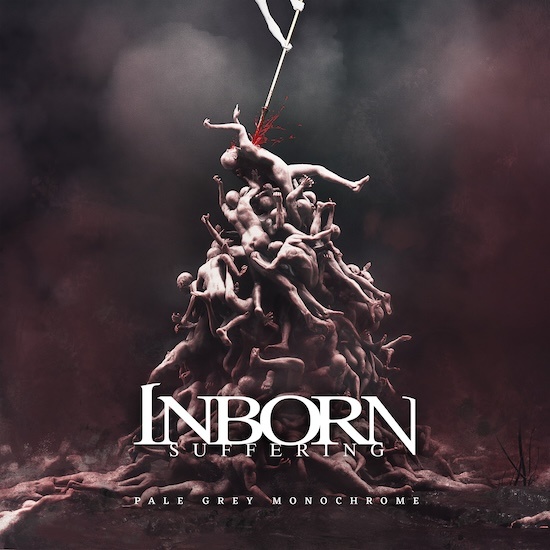
(written by Islander)
Inborn Suffering came together in Paris in 2002. They released two albums that made substantial impact craters in the landscape of doom, Wordless Hope in 2006 and Regression To Nothingness in 2012, and then they sunk into lightless depths for a long time. After returning with singles in 2023 and 2024, they now have a new album for us that will be released on February 7th by Ardua Music.
The name of the new album, Pale Grey Monochrome, is not an inviting one. It’s more fitting as a description of a winter sky hiding the sun beneath a curtain of slate that stretches from horizon to horizon than as a come-on for new music. It seems to promise a colorless gloom, drab and featureless. There is a reason for the name, but the music is the antithesis of monochromatic, as you will soon see.
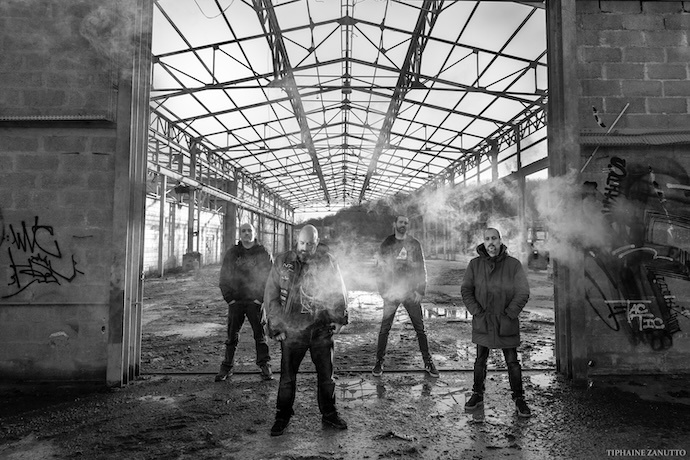
The reason for the name can be understood from extensive comments we will be sharing from bassist Emmanuel Ribeiro at the end of this article, comments that include insights into each of the album’s seven songs. Lyrically, the album reflects a long period of depression and darkness in his own life, a long pale grey sky above a cold sea, a perspective captured in these words:
He stands upon the shore of a turbulent winter sea, snow drifting about his feet upon the dull, wet sand. A chill wind blows in across the colourless waves that reflect the colourless sky above, cutting through his thin shirt and carelessly unbuttoned coat that hangs uselessly from one shoulder. It bites at his skin with teeth like needles of ice, but he has no sense of feeling within or without. His empty eyes stare at the storm-tossed waters and he wonders if there is comfort to be found there, in the deep, dark places, hidden from the sun. A peace without end…
But the music is another thing. It joins together the talents of both newer and older members of the band. Doom metal is what they have rendered, to be sure, but oh, the colors they have made… they remind us that not even the coldest sky is truly featureless and that beneath every sea is a turbulent power that won’t be still for long.
The album opens with “Wounding“, the album’s shortest track by far, and one that (in Emmanuel‘s description) “perfectly embodies the sound of a suffocating mind.” Though brief and musically gentle and somber, the track includes an agonized voice that appears before the end which is in line with that description, and is a signpost to where some of the subsequent music will travel.
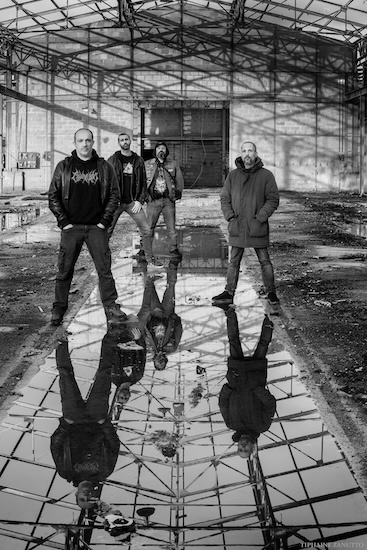
After that introduction, “From Lowering Tides” more fully reveals the band’s songwriting and performance talents and the breadth of the album’s scope. At nearly 11 minutes in length, it is a ranging journey. It includes slow punching rhythms, layered guitars that both ring out and groan melodies of sorrow and distress, and immense, cavernous growls that flare in pain.
It also includes echoing spoken words, singing that haunts and soars, eerily shimmering keys that expand like a sunrise, and harder-hitting grooves that jolt a listener’s bones, as well as lonely softer notes, guitars that throb like a worried vein, the swell of hammering drums, and a piercing solo that sounds forlorn beseeching.
The song’s range stretches from beleaguered sensations of internal suffering and hopelessness to heights of immense but tragic grandeur, and its recurring motifs succeed in penetrating the mind deeply enough that they stay there.
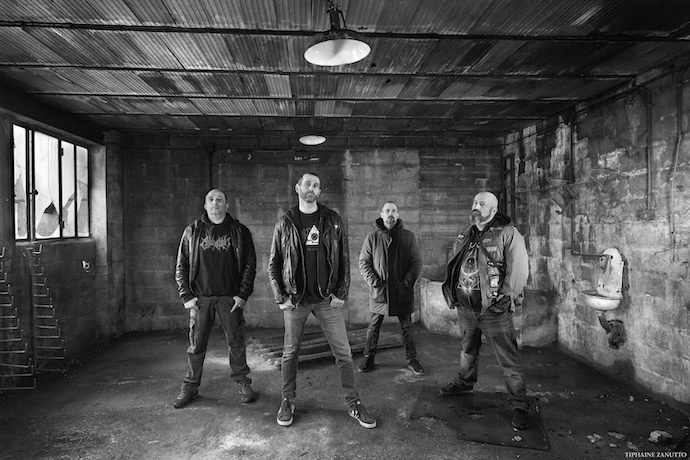
Some other deep plunges into doom and death lie ahead, with the 11 1/2 minute title song and the 13 minute “Tales From An Empty Shell.”
The former is more overtly funereal than the preceding song, both in its funeral-doom pacing and in the solemn, grief-stricken impact of its gritty opening riff.
Other notes, both brittle and shining, slowly wail, and both the music and the ravaging vocals also rise, in a conjunction of splendor and despair. (The way the gargantuan growls rip open into screams is always shattering, every time it happens throughout the album.)
“Pale Grey Monochrome” also ebbs and flows. At low tide the interplay of acoustic guitar and bell-like chiming is beautiful, like a wistful but wonderful remembrance, both earthy and ethereal. The musical sea also flows — expansive, elegant, and even more wondrous, but with neck-snapping beats and heaving undercurrents riding along. As it flows and begins to surge, it’s also heart-aching to hear.
“Tales From An Empty Shell” creates an immediate contrast, more subdued than the way the title song ended, but also stricken in its mood. It also moves like a powerful tide, surging and receding. It often hits very hard, and there’s a feeling of danger in the music when it does, in the cold undertow of the riffing and the violence of harrowing howls and crashing beats.
It can also feel like a slow drift into increasingly dark depths lit only by a phosphorescent glow. The soloing is again beautiful but heart-breaking to behold, the drumming is often compulsively head-moving (as well as gut-punching), and the melodic hooks dig deep.
“Of Loss and Despair” then provides a brief interlude. It’s a spellbinding acoustic track by Inborn Suffering‘s first guitarist, Loïc Courtete, augmented by celestial sonic emanations and an increasingly explosive spoken-word excerpt from Chaplin’s immortal final speech in The Great Dictator — which thematically feeds right into the next long song.
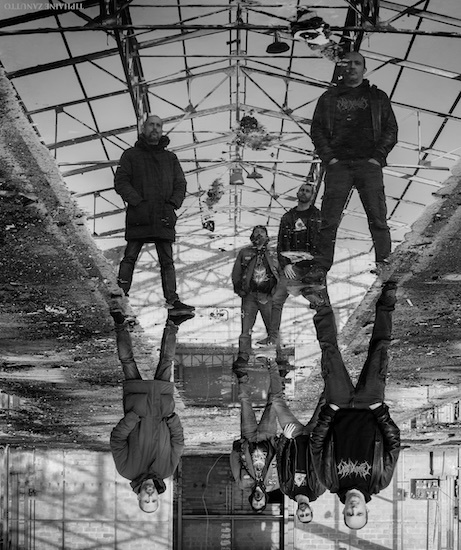
In some ways the album’s first five songs can be understood as a long build toward the sixth one, “The Oak“. In the band’s words: “The Oak is a poetic journey through despair and rebirth, the text explores forgotten truths and the collapse of illusions. Themes of divine absence, decay, and rage intertwine with imagery of ashes, sorrow, and renewal. Amid hollow emptiness and shattered identities, it envisions revival and rage-fueled transcendence.”
And we’ll add these words from Emmanuel‘s statement below:
Themes of despair, rebirth and hope are evoked. The Oak represents a voyage into the unknown, into uncertainty, oppressiveness and sacrifice. Earth seems to have died, but life, driven by greater forces, still fights on. The Oak stares at mankind’s mistakes and reminds human beings that they are anecdotical in this vast universe. Revival and transcendance seem to be the only way out towards a form of chaotic harmony.
We’ll add only that “The Oak” might be the darkest and most harrowing of the album’s songs, and while comparisons are difficult, the layered vocals might be the most wrenching, and terrifying.
After “The Oak“, only one song remains, “Drawing Circles“. Not an easy place for that song to occupy, given what’s just happened before it. Wisely, it opens gently and beautifully, and with sober spoken words instead of terrorizing growls and screams. But of course, it begins to elevate like the raising of a dark monument, daunting but magnificent, and the vocals tear themselves apart once more. Elaborately textured and layered, and with peaks and troughs of intensity and mood (as always), it makes for a sublime finale.
With that very long introductory review behind us, we’ll step aside and leave you to the album in its hour-long entirety. Pale Grey Monochrome is a stunning achievement, and an album that no self-respecting fan of doom-death metal, or anyone else who seeks genuine emotional power and multi-faceted artistry in music, should miss.
INTERNAL SUFFERING:
Laurent Chaulet – Vocals/Guitars
Emmanuel Ribeiro – Bass
Stéphane Peudupin – Guitar
Thomas Rugolino – Drums
ADDITIONAL CONTRIBUTIONS:
Solo on track 2 : Loïc Courtete
Acoustic guitars on track 5, 6 and 7 : Loïc Courtete
Main vocals on track 6 : Frederic Simon
Bass guitar on start of song 7 : Mathilde Depernet
Pale Grey Monochrome was mixed and mastered by Déhà at Opus Magnum Studio (Abduction, Deadspace, Wolvennest, etc), and it is completed by the arresting artwork of Franck Besançon (Maveth, Solemn Lament, Silent Hill: Townfall, etc).
Ardua Music will release it on CD and digital formats and recommends it for fans of: Paradise Lost, My Dying Bride, Shape Of Despair, and Officium Triste. The same label will also re-release Inborn Suffering‘s first two albums at the same time.
And don’t forget… below the links we have the extensive and insightful commentary of Emmanuel Ribeiro about the album.
PRE-ORDER:
https://www.arduamusic.com/
https://arduamusic.bandcamp.com/album/pale-grey-monochrome
https://inbornsuffering.bandcamp.com/album/pale-grey-monochrome
INBORN SUFFERING:
https://www.facebook.com/inbornsufferingdoom/
https://inbornsuffering.bandcamp.com
To be honest, I never thought that after all these years of absence, we would manage to release a new album. It was a long and difficult process. Writing new music and lyrics while battling different stages of depression is no easy task. However, I can confidently say that this album is the most sincere work we’ve ever created. Not only do the lyrics reflect this, but the new approach of long-distance composition has brought something unique. A tremendous effort has gone into this album, and it’s not just another “Inborn Suffering” record – it’s something different, more direct.
On the lyrics: Pale Grey Monochrome is, almost entirely (with the exception of The Oak), a reflection of the past three years of my life. This is why the album feels darker than our previous works.
This time, the majority of the music was composed by Laurent, who has perfectly captured the despair expressed in the lyrics.
The album opens with Wounding. This track perfectly embodies the sound of a suffocating mind – there’s no better introduction to what’s to come on The Oak.
Stéphane does an incredible job of creating atmospheres and arrangements here.
From Lowering Tides is probably the most “Inborn” song on the album, featuring catchy melodies reminiscent of Apotheosis, which evolve continuously until the very end. And to top it off, Déhà‘s clean vocals are absolutely stunning.
Pale Grey Monochrome takes a more funeral-like approach. With bells and choirs – elements we haven’t really used before – it has a religious undertone that perfectly complements the album cover. It evokes images of abandoned souls unable to reach the light.
Tales from an Empty Shell was the first song we wrote after all this time – a true dawn of a new era for us. The lyrics are particularly powerful, paired with an incredible atmosphere. And that ending…
Of Loss and Despair is an acoustic track by Loïc Courtete, our first guitarist. We wanted to recreate the Wordless Hope atmosphere, and Loïc delivered beautifully with his acoustic contributions. We’re really proud of this track — it feels like the calm before the storm that is The Oak.
The Oak is darker and more oppressive, designed to provoke a wide palette of emotions.
Themes of despair, rebirth and hope are evoked. The Oak represents a voyage into the unknown, into uncertainty, oppressivness and sacrifice. Earth seems to have died, but life, driven by greater forces, still fights on. The Oak stares at mankind’s mistakes and reminds human beings that they are anecdotical in this vast universe. Revival and transcendance seem to be the only way out towards a form of chaotic harmony.
Written entirely by Stéphane, The Oak is probably the most brutal song we’ve ever created. It also marks the return of Frédéric Simon, who takes on the main vocals for this track.
When I began writing the lyrics for Drawing Circles, I knew they would be for the final song on the album. It’s a more post-metal-inspired piece that gradually fades away, bringing the journey to a haunting close.

No Responses to “AN NCS ALBUM PREMIERE (AND A REVIEW): INBORN SUFFERING — “PALE GREY MONOCHROME””